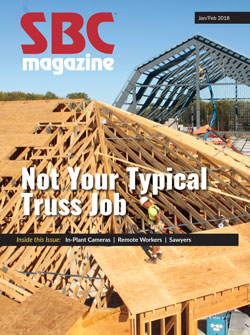Watch & Learn
Watch & Learn
“We have no intention of being Big Brother,” says Keith Myers, truss and panel general manager of Woodhaven Lumber in Lakewood, New Jersey. “However, having surveillance cameras positioned throughout our facility provides a lot of benefits that other component manufacturers could realize as well.” From increasing security to improving the quality of temporary workers, the cameras Woodhaven installed six years ago have provided a significant return on investment.
“We originally installed them to bolster security throughout our lumber yard and production facility,” says Keith. If something disappeared, it wasn’t hard to go back to the tape and find out when and how it happened.
“Not only does it deter theft, it can also be handy in locating something that gets lost if an employee knows when and where they last saw it,” notes Keith. That use of the footage points to an important aspect of this kind of surveillance. No one at Woodhaven Lumber is watching the camera feeds real-time; instead, the recordings are saved for 30 days. If anything happens during that time period, Keith can go back to the recordings to see the incident.
“Sometimes it takes longer to find what I’m looking for than I’d like, but it has still proven invaluable to me,” says Keith. The ability to review an incident is particularly helpful when it comes to accidents, insurance claims and safety training.
Improving Safety
“When an accident occurs, I always ask what happened, and then I go and check the video,” says Keith. “The camera can’t lie. It shows exactly what happened, when it happened and who did what.” That reality means the initial report Keith gets from employees after an incident has gotten more accurate over the years. “I don’t make it a secret that we have cameras recording what they’re doing.”
Having video footage of accidents also goes a long way when filing insurance claims. “They start asking me questions about how and when, and I just respond, ‘would you like to see it as it happened?’”
Keith also likes to use the footage of accidents and near-misses to bolster his regular safety trainings. “I edit down the video and use clips to show what not to do. I try to share the footage as much as possible because it drives home the point faster than me lecturing them. In the end, everyone has a stronger focus on doing things safely.”
Increasing Efficiency
The cameras also allow Keith to evaluate production efficiency throughout his facility. “Again, I’m not watching the camera feeds, but they are capturing the entire fabrication process and material handling in the yard.”
Periodically, Keith will conduct an ad hoc time study by reviewing the video of a production line and watching for ways to improve the process. “I look for things that might be causing bottlenecks or approaches that are causing employees to have to stand around and wait. Then we talk about them and look for ways to minimize those delays.”
Multiple camera feeds allow Keith to watch the process from different angles. “It’s better than being on the floor standing over their shoulder. If they know you’re watching them, they’ll speed up, but because it’s passive surveillance they forget about it and you get a true picture of what’s going on every day.”
Woodhaven runs two production shifts, so Keith can’t always be in the shop. Fortunately, with the cameras, he has the ability to check in remotely and see what’s going on. “I have an app on my phone that allows me to access the camera feeds and ensure everything is going all right even when I’m not there.”
Preparing Potential Employees
The final benefit Keith points out is how the video footage has helped his relationships with the four temporary employment agencies he uses. “I’ve pulled together video clips for the temp agencies to show to people they are considering sending to us. Those videos do a great job showing them we work hard and get a lot done each day. It’s a labor-intensive job.” The video has proven to be an effective pre-screening tool, reducing the number of people who show up in the morning and leave at lunch or after one day’s work.
Fortunately, high-definition cameras are not prohibitively expensive these days, and setting up the recording and electronic file storage system isn’t beyond the current IT needs of a typical design department. Given the many advantages he’s realized through Woodhaven’s system, Keith says, “I think every component manufacturer should consider cameras.”
What kind of cameras can provide new insights into your business?
Check out the digital edition of this article for an additional page on Woodhaven's recording equipment configuration.

